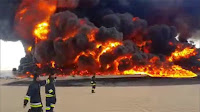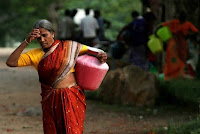Hydrothermal vents are areas on
the sea floor where water warmed by the heat of the Earth’s interior escapes
into the wider ocean. These waters contain high levels of dissolved minerals
and nutrients rare in the wider oceans, and therefore support unique ecosystems
able to survive without any input of solar energy. The most extreme examples of
hydrothermal vents are the black smokers found around volcanically active ocean
ridges. These vents produce water with temperatures reaching hundreds of
degrees centigrade, kept liquid only by the high pressures present on the ocean
floor, and opaque due to the high levels of minerals present. However
hydrothermal vents are also present on areas of the ocean floor far from the
active ridges, or any other form of volcanic influence, apparently emitting
water that has been transported hundreds of kilometres beneath the ocean floor,
which is far harder to explain.
Marine sediments tend to be very
rich in clay minerals, and are thus effectively impermeable to the flow of
water. However the volcanic rocks that lay beneath these sediments tend to be
highly porous, allowing the free transport of water. Therefore areas of exposed
rock can act as either entrances or exits for water moving through subsurface
aquifers, which are isolated from the general ocean in areas where the volcanic
bedrock is covered by sediments. Observational evidence from around the Juan de
Fuca Ridge suggest that whether an area of exposed volcanic rock serves as an
entrance or exit to the aquifer is driven by the size of the exposure rather
than other factors, such as proximity to volcanic heating, or the temperature
or current speeds of the water passing over the entrances, with hydrothermal
vents (i.e. areas where water exits from the aquifers) always occurring from
exposed rocks with limited areas.

Geometry and configuration of 3D domains. Domains represent a section
of upper ocean crust, oriented with the long-axis parallel to the spreading
ridge, consistent with conditions at a field site on the eastern flank of the
Juan de Fuca Ridge. A conductive volcanic rock section (red, lower
permeability) is overlain by a crustal aquifer (orange, higher permeability)
and marine sediments (blue, lower permeability) and two volcanic rock outcrops
penetrate through the sediment (light blue). Heat is applied to the base,
following a lithospheric cooling trend. The sides and base are no-fluid flow
boundaries, and the top is free flow (fluid and heat) with pressure varying as
a function of seafloor depth. Winslow & Fisher (2015).
Winslow and Fisher simulated
flows between outcrops of different sizes, through subsurface aquifers being
heated gently but evenly and constantly from below. They initially tried
modelling systems where the current was present at the start of the experiment,
on the basis that establishing a system and maintaining it are not the same,
but found that even where no current was present at the outset of the
experiment, a current flow from the larger opening to the smaller was quickly
established.
Larger areas of permeable rock
exposure allow both the entrance and exit of water across their surface,
whereas smaller openings allow movement in only one direction. As warmer water
rises from the vent into the water column warm water exiting from the vent
quickly comes to dominate the flow of water at smaller vents, particularly if
these are raised above the surrounding area (i.e. sticking up through the mud).
This in turn leads to a draw on the waters of the aquifer, effectively pulling
water through from the larger areas of exposure.

Simulation results at dynamic steady state. This simulation, showing
one quarter of the domain illustrated in the top figure, has one large outcrop
and one small outcrop. Domain colours show domain temperatures, including
influence of rolling/mixed convection in basement aquifer and thermal influence
of recharging/discharging outcrops. Inset diagrams show fluid flow vectors within
and around outcrops (length indicates flow rate), with vectors plotted on a
natural-log scale, the longest vector (exiting the top of the discharging
outcrop) corresponding to a flow rate of 14m per year. Fluid flow through the
sediment is so slow that it would generate no detectable thermal or geochemical
anomalies. Vertical exaggeration (VE) of main image is times three; VE of inset
images is times two. Winslow & Fisher (2015).
Hydrothermal vents are thought to
account for about 25% of heat loss from the Earth’s interior, which if correct
suggests that a very large amount of water is exiting from such vents every
day. Despite this such vents are notoriously hard to find, with efforts to
locate them with satellites having been largely inconclusive, and most known
vents having been discovered by exploratory missions involving deep-sea
submersibles. Winslow and Fisher’s findings suggest that a preference for such
vents occurring on smaller outcrops is a genuine natural phenomenon, rather
than a product of the observation methods being used. This would explain the
difficulty in finding such vents using satellites, as very small discrete
vents, no matter how numerous, would fall below the area/size at which it was
possible to detect them using remote sensing technology.
See also…
A seismic monitoring system beneath the northeast Pacific operated by the Ocean Observatories Initiative has detected a probable eruption on Axial Seamount, a submarine volcano roughly 480 km off the coast of Oregon. The network has detected...
Hydrothermal vents in the deep oceans are colonized by a broad array of invertebrates that have symbiotic relationships with chemotropic Bacteria. These Bacteria are able to derive energy from chemicals discharged by the vents, providing a base for ecosystems entirely separated from the light of the Sun. Not all...
Deep sea hydrothermal vents are unique ecosystems where the food chain is based not upon the photosynthetic activity of plants or algae, but rather of chemotrophic bacteria that gain their energy from...

































